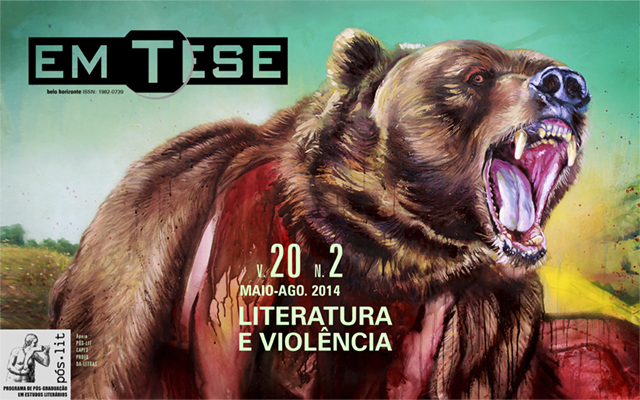The homecoming experience
the enemy never dies
DOI:
https://doi.org/10.17851/1982-0739.20.2.208-229Palavras-chave:
Vietnam veteran, Post-war, War experience, War literatureResumo
Resumo:
O foco desse artigo está em como o período pós-guerra do Vietnã afetou os veteranos nos Estados Unidos, colaborando para entender como a representação da nova identidade destes militares reformados foi moldada pelas consequências das experiências traumáticas que eles sofreram. As dificuldades que os veteranos tiveram para se reintegrar na sociedade começam nos aeroportos dos E.U.A. assim que eles pisam em solo americano. A forma como eles são representados no período subsequente a guerra é o propósito principal da investigação aqui apresentada. As narrativas de guerra essenciais usadas para ilustrar esta investigação são Paco Story, de Larry Heinemann, e Born on the Fourth of July, de Ron Kovic. Os personagens literários Kovic e Paco atuam em papéis importantes que representam o processo de transformação da identidade dos veteranos. Essa mudança passa pela investigação de novos lugares de ameaça, inimizades e conflitos que foram gradativamente revelados na vida dos ex-combatentes durante o período de retorno ao lar.
Referências
APPY, G. Christian. Working-class war: American combat soldiers and Vietnam.U of North Carolina P, 1993.
BAL, Mieke, Jonathan Crewe and Leo Spitzer, eds. Acts of Memory: Cultural Recall in the Present. Hanover: UP of New England, 1999.
BARITZ, Loren. Backfire: A History of How American Culture Led Us into Vietnam and Made Us Fight the Way We Did. New York: W. Morrow, 1985.
Bibby, Michael.Hearts and minds: bodies, poetry, and resistance in the Vietnam era. Rutgers UP, New Brunswick, New Jersey, 1996.
CAPPS, Walter. The Vietnam Reader. Routledge, New York, 1991.
CAPUTO, Philip. A Rumor of War.New York: Ballantine, 1978.
CARUTH, Cathy. Trauma: Explorations in Memory. Baltimore: The Johns Hopkins UP, 1995.
CARUTH, Cathy. Unclaimed Experience: Trauma, Narrative and History. Baltimore: The Johns Hopkins UP, 1996.
CARUTH, Cathy. “Confronting Political Trauma.” CT Review Vol. XXVIII No. 1 (Spring 2006): pp. 179-18.
CHAMBERS II, John Whiteclay.The Oxford Companion to American Military History.Ed. John Whiteclay Chambers II. New York: Oxford UP, 1999.
CLARK, Michael. “Remembering Vietnam.”Cultural Critique, No. 3, American Representations of Vietnam3,1986,p.46-78.JSTOR. Disponívelemhttp://www.jstor.org/stable/135416. Acesso em 15 dez. 2011.
EASTLAKE, William. The Bamboo Bed. New York: Simon & Shuster, 1969.
ELLSBERG, Daniel. Papers on the War. New York: Simon and Schuster, 1972.
ERIKSON, E.H. Childhood and Society, Harmondsworth: Penguin Books, 1965.
FITZGERALD, Frances. Fire in the Lake: The Vietnamese and the Americans in Vietnam. Boston: Little, Brown & Co.,1970.
FRANKLIN, H. B. Mythmaking in America. Lawrence Hill, New York, 1992.
HALBWACHS, Maurice. On collective Memorie, Chicago U P, 1992.
HANLEY, Lynne.Writing War: Fiction, Gender, and Memory. Amherst: U of Massachusetts P, 1991.
HARIMAN, Robert and John Louis Lucaites. “Public Identity and Collective Memory in U.S. Iconic Photography: The Image of ‘Accidental Napalm’.” CriticalStudies in Media Communication20.1. Mar.2003. p.35-36. Disponível em http:// www.uni.edu/fabos/seminar/readings/Harriman2.pdf Acesso em 01 jul. 2014.
HENDIN, Herbert, and Ann Pollinger Haas.Wounds of War. New York: Basic Books, 1984.
HEINEMANN, Larry. Paco’s Story. Faber and Faber, London, 1989.
HERMAN, Judith. Trauma and Recovery.New York: Basic Books, 1992.
HERR, Michael. Dispatches. New York: Avon Books, 1980.
HERZOG, Tobey C. Vietnam War Stories: Innocence Lost. Routledge, New York, NY, 1992.
JEFFORDS S., TheRemasculinization of America: Gender and The Vietnam War, Indiana U P, Bloomington, 1989.
KOTARBA, J. A. Chronic Pain: Its Social Dimensions, Beverly Hills: Sage, 1983.
KOVIC, Ron. Born on the Fourth of July. New York: Pocket Books, 1976.
KOVIC, Ron. “Raise your voices, protest, stop these wars.” MarchForward, 09 Dez. 2010.Disponível em http://www.stopthesewars. org/2010/12/10/ron-kovic-%E2%80%98raise-your-voices-protest-stop-these-wars%E2%80%99/. Acessoem16 Nov. 2011.
LEWIS, Michael. Shame: The Exposed Self. New York: The Free Press, 1992.
LIFTON, Robert Jay. Home From the War, New York: Pocket Books, 1976.
LINDY, Jacob. Vietnam: A Casebook. New York: Brunner/Mazel, 1988.
LOMPERIS, Timothy J. “Reading the Wind” The Literature of the Vietnam War. Durham: Duke UP, 1987.
LUCKHURST, Roger. The Trauma Question.New York: Routledge, 2008.
LYONS, Paul. “Toward a Revised Story of the Homecoming of Vietnam Veterans.”Peace &Change, abr. 1998. Disponível em http://loki.stockton.edu/~lyonsp/graphics/toward_a_revised.pdf. Acessoem 01 de jul. 2014.
MELVILLE, Herman. Red Burn: His First Voyage. New York: Harper & Brothers, Publishers, 82 Cliff Street. 1850.
NEIL. Arthur G. “National Trauma and Collective Memory: extraordinary events in the American experience.”M.E. Sharpe, New York, 2005.
O’NAN, Steward. The Vietnam Reader. New York: Anchor, 1998.
O’BRIEN, T. If I Die In a Combat Zone: Box Me Up and Ship Me Home. Delacorte Press, 1973.
SCHULZINGER, Robert D. A Time for War: The United States and Vietnam, 1941-1975. New York: Oxford University Press, 1997.
SEARLE, Willian J. Search and Clear:Critical Responses to Selected Literature and Films of the Vietnam War. Bowling Green State UP, 1998.
SEVY, Grace. The American Experience in Vietnam: a reader. U of Oklahoma P, Norman, 1899.
TAL, Kali. Worlds of Hurt: Reading the Literature of Trauma. Cambridge U P, 1996.
WALSH, Jeffrey. American War Literature:1914 to Vietnam. St. Martin’s Press, 1982.
WHITE, Hayden. “The Historical Text as Literary Artifact.”Ed. Adams & Leroy Searle, eds. Critical Theory since 1965. Tallahassee: UP of Florida, 1986.
Young, Marilyn Blatt. The Vietnam Wars 1945-1990. New York: Harper Collins Publishers, 1991.





